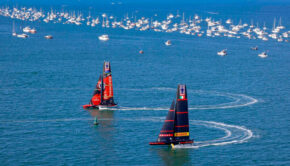Developing the Soft Wing Concept
Published on April 10th, 2018
When the AC75 Class Rule for the 36th America’s Cup was released in March, it included the details regarding a ‘soft wing’ mainsail concept. But unlike the hard wing, which had been in use prior to the America’s Cup, this sailplan idea was blazing new ground.
Utilizing North Sails patented Membrain™ software, senior designers Burns Fallow and Michael Richelsen led the collaboration between North Sails, America’s Cup defender Emirates Team New Zealand, and Challenger of Record Luna Rossa to develop this unique sail system.
“We started this project in September and we did not have a lot of time to figure out if this big idea was to be feasible or not, and there were some big questions to be answered,” said Fallow. “Questions like, how much are the loads shared between the windward and leeward sail skin? How will the batten/mast interaction work, and how much aerodynamic benefit will there be from this?
“It would be far too dangerous to guess those answers,” Burns continues. “I briefed Michael [Richelsen] on what we were trying to achieve and only two months later, after some intense software development, we could answer those big questions. Since that time we have been adding more and more features to make even more refined models. Overall, this is one the most exciting and progressive projects I have been involved with in my 30 years at North Sails.”
The two-element slotted hard wing used in the 34th and 35th America’s Cup [2013, 2017] provided the ultimate trim-ability, allowing trimmers to literally dial in any shape short of breaking the equipment. A slotted wing can be set with deeper cambers than a conventional soft sail, reaching a higher Maximum Lift Force. Secondly, the rigid control arms can force inversion of the upper sections, which creates righting moment by reversing the lift force.
But a hard wing is complicated, expensive, and impractical for sailing in general.
The soft wing is a hybrid between a conventional sail and hard wing. Pairwise battens (one in each section) actively control twist in the head area. The control of these battens can change the sail shape and thus performance. Though the section inversion of a soft wing cannot be as dramatic as it would be on a hard wing, the soft wing inverts much more than a conventional mainsail.
Unlike a conventional mainsail, a hard wing does not backwind when the traveler is moved down or the sail is twisted. The soft wing inherits this feature, thanks to the pairwise battens, so a soft wing can be depowered more than a conventional sail. This has proven to be a beneficial and widely used feature.
JB Braun, North Sails Head of Design and Engineering, is optimistic how this concept can have a trickle-down effect on sailing in the future. “Through our design work over the last 20 years on soft sails and hard wings, we were able to work closely with Emirates Team New Zealand and Luna Rossa Challenge to help move the sport forward with the new rule for the 36th Cup. The potential benefit of this work to the wider sport is huge.”
Below is the development and testing of the new mainsail concept in this video published on Feb 24, 2018.
Below is the AC75 boat concept revealed.









 We’ll keep your information safe.
We’ll keep your information safe.